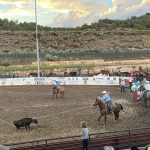Haims: Getting your body in shape for tennis and pickleball
Now with the warm weather upon us and the outdoor courts reopening, tennis and pickleball enthusiasts are returning to the game they love. Whether you’re heading onto the courts for casual fun or perhaps more competitive play, preparing your body is crucial. Jumping into full-speed play without preparing your body often leads to setbacks of soft tissue injuries like strains and sprains. Such injuries can derail a summer of fun before it even gets started.
As mentioned over the past few weeks, one of the biggest mistakes recreational athletes make is diving into their sport of choice after months of limited exercise and/or training. As both tennis and pickleball require constant pivoting, lunging, twisting and quick changes in direction, injuries such as sprains and strains are quite prevalent.
Before diving into training strategies, it’s helpful to understand what strains and sprains actually are. A strain involves injury to muscles or tendons — the fibrous tissue that connects muscle to bone. Common strains in racket sports include hamstring pulls, calf muscle strains, and shoulder injuries. A sprain, on the other hand, is an injury to ligaments, the tissue connecting bones at a joint.
To gain some insight about what people can do to help prevent some of the common injuries associated with these sports, I reached out to Elie Sabins, one of the physical therapists at Howard Head Sports Medicine. Elie has a comprehensive knowledge of strength and conditioning principles along with musculoskeletal issues. Further, she has extensive knowledge to share about injury prevention, treatment and rehabilitation specific to these two sports.
Here are some of the questions I asked:

Support Local Journalism
For those that have not yet begun training to play tennis and/or pickleball this summer, what suggestion would you have to prepare our body for the relentless pounding, repetitive motion, and extreme movements needed to play these sports?
The best thing you can do if you haven’t started training yet is to begin a strength training program but know that it will take time to build strength in your muscles, so it is best to prepare for the season ahead of time. The next best things are to warm up appropriately (performing sports specific movements you are about to do) and to ease into the sport (not doing too much, too fast).
Much different than the linear direction of skiing, tennis and pickleball require that a player be able to make quick stops and changes in direction, moving forward and backward in an instant, along with quick side-to-side motions. What muscle groups and training should people consider in effort to avoid sprains and strains?
Lots of lower extremity exercises that include agility tasks are good to prepare your body for these activities, specifically targeting your quadriceps, hamstrings, glutes and calves.
Tennis and pickleball require a lot of rotational strength as people use their forehand and backhand strokes. What muscle groups should be focused on and what training suggestions do you have to strengthen these muscles?
Working on shoulder and upper extremity strength would be beneficial. Performing shoulder rotational exercises as well as strengthening your forearms, especially your wrist flexors and extensors will help.
Over the past few weeks, the importance of progressive loading to minimizing the risk of injury has been the premise of each column. By slowly increasing workload, stress is applied in a controlled manner that allows tissues to adapt — becoming stronger, more flexible and more resilient. Skipping this phase often leads to the “too much, too soon” phenomenon, where underprepared muscles and joints are suddenly pushed to their limits, resulting in painful setbacks.
Regardless of the sport you choose this summer, be safe and remember that a well-prepared body is more agile, more durable, and far less prone to injury. Don’t wait for pain to force you into rest — train early, train smart, and play strong all season long.
Judson Haims is the owner of Visiting Angels Home Care in Eagle County. He is an advocate for our elderly and is available to answer questions. Connect with him at jhaims@visitingangels.com.










